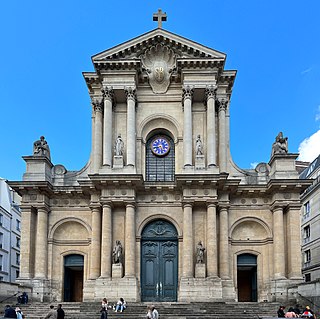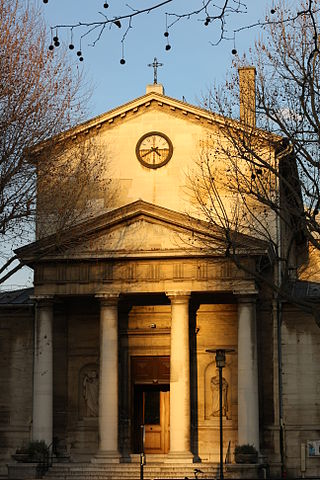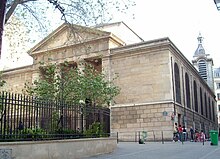
Saint-Julien-le-Pauvre, in full Église Saint-Julien-le-Pauvre, is a Melkite Greek Catholic parish church in Paris, France, and one of the city's oldest religious buildings. Begun in Romanesque style during the 12th century, most of its architecture is Primary Gothic. It is situated in the 5th arrondissement, on the Left Bank of the Seine River, about 500 meters away from the Musée de Cluny and in the proximity of the Maubert-Mutualité Paris Métro station. It shares a city block with the Square René Viviani.

The Church of Saint-Germain-des-Prés is a Roman Catholic parish church located in the Saint-Germain-des-Prés quarter of Paris. It was originally the church of a Benedictine abbey founded in 558 by Childebert I, the son of Clovis, King of the Franks. It was destroyed by the Vikings, rebuilt, and renamed in the 8th century for Saint Germain, a 6th century bishop. It was rebuilt with elements in the new Gothic style in the 11th century, and was given the first flying buttresses in the 12th century. It is considered the oldest existing church in Paris.

The Church of St. Eustache, Paris, is a church in the 1st arrondissement of Paris. The present building was built between 1532 and 1632.

Saint-Pierre de Montmartre is the second oldest surviving church in Paris, after the Abbey of Saint-Germain-des-Pres. It is one of the two main churches on Montmartre, the other being the more famous 19th-century Sacré-Cœur Basilica, just above it. Saint-Pierre de Montmartre, begun in 1133, was the church of the prestigious Montmartre Abbey, destroyed in the French Revolution.

The Église de la Sainte-Trinité is a Roman Catholic church located on the place d'Estienne d'Orves, at 3 rue de la Trinité, in the 9th arrondissement of Paris. It was built between 1861 and 1867 during the reign of Emperor Napoleon III, in the residential neighborhood of the Chaussée d'Antin. It is in the ornate Neo-Renaissance or Second Empire Style, with a highly visible 65-meter-tall belfry.

The Church of Saint-Merri or Église Saint-Merry) is a parish church in Paris, located near the Centre Pompidou along the rue Saint Martin, in the 4th arrondissement on the Rive Droite. It is dedicated to the 8th century abbot of Autun Abbey, Saint Mederic, who came to Paris on pilgrimage and later died there in the year 700. In 884 Mederic was declared patron saint of the Right Bank.

The Basilica of Saint Clotilde is a basilica church located on the Rue Las Cases, in the 7th arrondissement of Paris. It was constructed between 1846 and 1856, and is the first example of a church in Paris in the neo-Gothic style.

Saint-Louis en l'Île is a Roman Catholic parish church located at 19 Rue Saint-Louis en l'Île on Île Saint-Louis in the 4th arrondissement of Paris, France. It was constructed between 1664 and 1725, and is dedicated to King Louis IX of France, or Saint Louis. The church was originally built in the French Baroque style of the 17th century, but much of the interior decoration was taken or destroyed in the French Revolution. The church was extensively restored and redecorated in the 19th century.

Located at 6, rue Notre-Dame-des-Victoires, in the 2nd arrondissement of Paris, The Basilica of Notre-Dame-des-Victoires is one of ten minor basilicas located in the Île-de-France region of France. It was begun as an Abbey church, and constructed between 1629 and 1740 in the French classical style. Its name was given by King Louis XIII, who dedicated it to his victory over the Protestants at La Rochelle in 1628 during the French Wars of Religion. Notre-Dame-des-Victoires is famous for the ex voto offerings left there by the faithful. Over 37,000 devotional plaques, silver and gold hearts, as well as military decorations, have been left at the basilica. The closest Métro station is 'Bourse'.

The Church of Saint-Roch is a 17th–18th-century French Baroque and classical style church in Paris, dedicated to Saint Roch. It is located at 284 rue Saint-Honoré, in the 1st arrondissement. The current church was built between 1653 and 1740.

The Church of Saint-Nicolas-des-Champs is a Catholic church in Paris' Third arrondissement. Early parts of the church, including the west front, built 1420–1480, are in the Flamboyant Gothic style, while later portions, including the south portal, mostly built 1576–86, are examples of French Renaissance architecture. It is notable particularly for its Renaissance carved sculpture, decoration and large collection of French Renaissance paintings in the interior.

Notre-Dame-de-Lorette is a Roman Catholic church located in the 9th arrondissement of Paris, It was built between 1823 and 1836 in the Neo-classical architectural style by architect Louis-Hippolyte Lebas, in a neighbourhood known as the New Athens, for its many artistic and scholarly residents in the 19th century, including George Sand, Pierre-Auguste Renoir, and Alexandre Dumas. While the exterior is classical and austere, the church interior is known for its rich collection of paintings, sculpture, and polychrome decoration.

Notre-Dame des Blancs-Manteaux is a Roman Catholic parish church at 12 Rue des Blancs-Manteaux in Le Marais, in the 4th arrondissement of Paris. It takes its name from the "Les Blancs-Manteaux", for the cloaks worn by the mendicant Augustinian Order of Servites, who founded the first church 1258. It was rebuilt between 1685 and 1689 in the French Baroque or French neoclassical style. It is noted for its remarkable carved wood pulpit (1749) and its collection of paintings and sculpture.

Église Saint-Joseph-des-Carmes (Saint-Joseph-des-Carmes) is a Roman Catholic church located at 70 rue de Vaugirard in the 6th arrondissement of Paris. It was originally built as the chapel of a convent of the mendicant order of Shoeless Carmelites. It is now the church of the Catholic Institute of Paris, a university-level seminary for training priests, and is also a parish church for the neighbourhood. It is dedicated to Saint Joseph, husband of the Virgin Mary. Built between 1613 and 1620, it combines elements of Classical architecture on the exterior with a remarkable display of Baroque architecture and art in the interior. The chapel is open to the public at limited hours.

Saint-Thomas-d'Aquin is a Roman Catholic church located in the 7th arrondissement of Paris, place Saint-Thomas-d’Aquin, between the rue du Bac and the boulevard Saint-Germain. The church is named for Saint Thomas Aquinas, a Dominican friar and priest, and influential philosopher and theologian in the 13th century. It was originally a chapel of an abbey of the Dominican order in Paris. Construction began in 1682, and the church was consecrated in 1682. The friars were expelled and the church was closed during the French Revolution, and was not returned to the Catholic church until 1802. During the 19th century, the City of Paris endowed the church with many fine examples of French religious art. The church was declared an Historic Monument in 1982.

The enclos paroissial or Parish close of Locronan comprises the parish church with adjoining chapel and a calvary. The article will also cover the nearby chapelle Notre-Dame-de-Bonne-Nouvelle. Locronan is a member of the Les Plus Beaux Villages de France association. The village's name means the "hermitage of Ronan", from the Breton lok which means hermitage, and after the founder Saint Ronan. It has previously been known as Saint-René-du-Bois. Saint Ronan is greatly venerated in Brittany. He was an Irish Christian missionary of the 6th century who came to the region to teach Christianity. As a consequence of Saint Ronan's close association with Locronan some of his relics are kept in the parish church. Locronan is located in the Châteaulin arrondissement of Finistère.

Église Saint-Eugène-Sainte-Cécile is a Roman Catholic church located at 6 rue Sainte-Cécile in the 9th arrondissement of Paris. In 1983 it was designated as a monument historique in its entirety. Designed in the Neo-Gothic style by Louis-Auguste Boileau and Louis-Adrien Lusson, the church was the first in France to use an entirely iron-framed construction. The first stone was laid in 1854, and the building was completed in 1855.

The Notre-Dame-de-la-Nativité de Bercy church is a Catholic church located in the 12th arrondissement of Paris, in the Bercy district, on Place Lachambeaudie. It is also often called Notre-Dame de Bercy.

Notre-Dame-de-la-Compassion is a Roman Catholic Church located on Place du Général Koenig in the 17th arrondissement in Paris. It was originally built in 1842–43 as a memorial chapel to Ferdinand Philippe, Duke of Orléans, the heir to King Louis-Philippe of France, who was killed in a road accident in 1842. It was built in the Neo-Byzantine style, with elements of Gothic, Baroque and other styles, and was originally called the Chapelle Royale Saint-Ferdinand. In 1970 it was moved stone by stone from its original location a short distance away to make space for the new Palais des Congrès. It became a parish church in 1993. Its notable decoration includes stained glass windows designed by Jean-Auguste-Dominique Ingres, and sculpture by Henri de Triqueti. It was designated a French historic monument in 1929.

The Church of Saint-Denys-de-Saint-Sacrament is a Roman Catholic church located in the Marais quarter, at 68 Rue de Turenne in the 3rd arrondissement of Paris, France. It was constructed between 1826 and 1835, It took its name from Saint Denys, the first bishop of Paris, and from the church of the Benedictines of the Perpetual Order of the Saint Sacrament, which had previously occupied the site. The early church was too small for the growing congregation and was replaced by the larger present church. It is an example of Neoclassical architecture, a style very popular in Paris the first half of the 19th-century.






























